Bayern Munich’s season hasn’t entirely all gone to plan. After putting Hansi Flick in charge in November, Bayern have progressed up the Bundesliga table, finding themselves in first place, four points ahead of their rivals, Borussia Dortmund. One of the key struggles that Flick has had to overcome is injuries, particularly those to his centre-backs. While having Lucas Hernández, Niklas Süle, David Alaba, and Jérôme Boateng on the roster, both Hernández and Süle have battled their own long-term injuries this season. This has opened up the opportunity for Boateng to line up next to Alaba consistently for the Bavarian club — an opportunity of which he has looked to take advantage. Boateng’s contract expires in June of 2021, and there have been rumours of him leaving Bayern this summer.
This tactical analysis provides a scout report on Jérôme Boateng under Hansi Flick at Bayern Munich. The analysis of Boateng functioning in Flick’s tactics will highlight Boateng’s strengths and weaknesses at Bayern Munich. While Boateng is 31 and soon entering the final year of his contract in Bavaria, he can still help fortify most defences in Europe, should he choose to leave.
Defensive positioning
As a central defender, Boateng’s most important job is obviously to prevent opponents from scoring. One of his best qualities that allow him to do this so successfully comes down to the positioning he takes. Boateng does well to consider the ball, his opponents, and the space that he is trying to protect in order to effectively shut down attacks. The first example comes from Bayern Munich’s match against RB Leipzig.
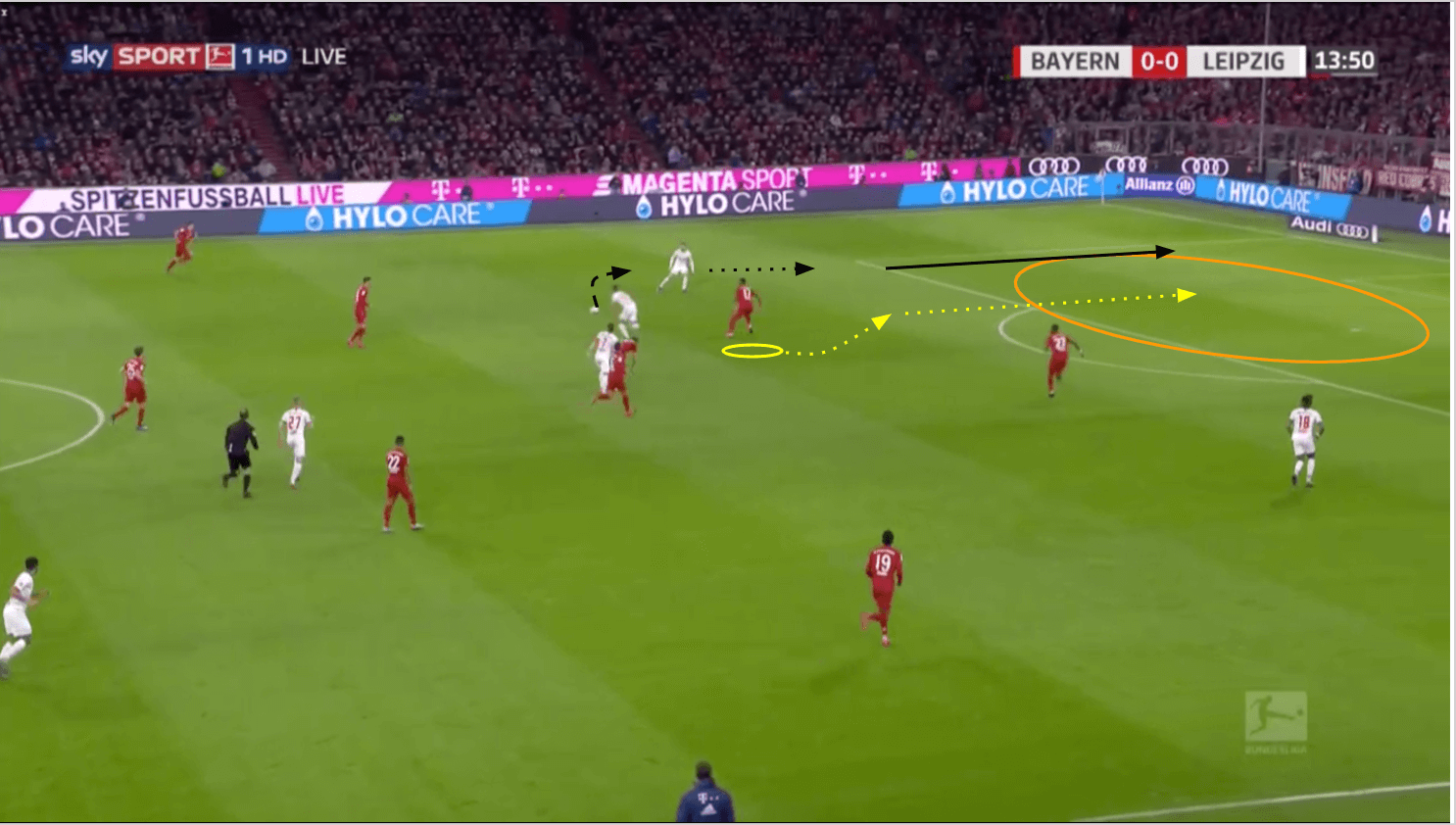
Dani Olmo recovered a loose ball in Bayern’s half, causing the Bayern defence to scramble to organise. Here, Boateng is alone against both Dani Olmo and Timo Werner. Most times, Leipzig would look to create this numerical and qualitative overload; however, Boateng used his positioning to beat out his opponents. His first two steps were not directly toward Werner, but rather back towards his own goal. While this allowed Werner to open up out wide, it eliminated Olmo’s possibility of playing an early pass into the penalty area. This forced Olmo to play Werner the ball. Boateng didn’t immediately step to Werner, knowing that the quicker winger would likely beat him and go in on goal. Instead, knowing Werner had no angle to shoot, Boateng backed off, daring him to cross. Werner attempted to do so, and Boateng was able to deflect it out of the penalty area.
In the match against Leipzig, Boateng was often tasked with the responsibility to man-mark Timo Werner. This would happen any time Benjamin Pavard would push higher up the pitch, which occurred quite often. This effectively shifted Bayern to a back three.
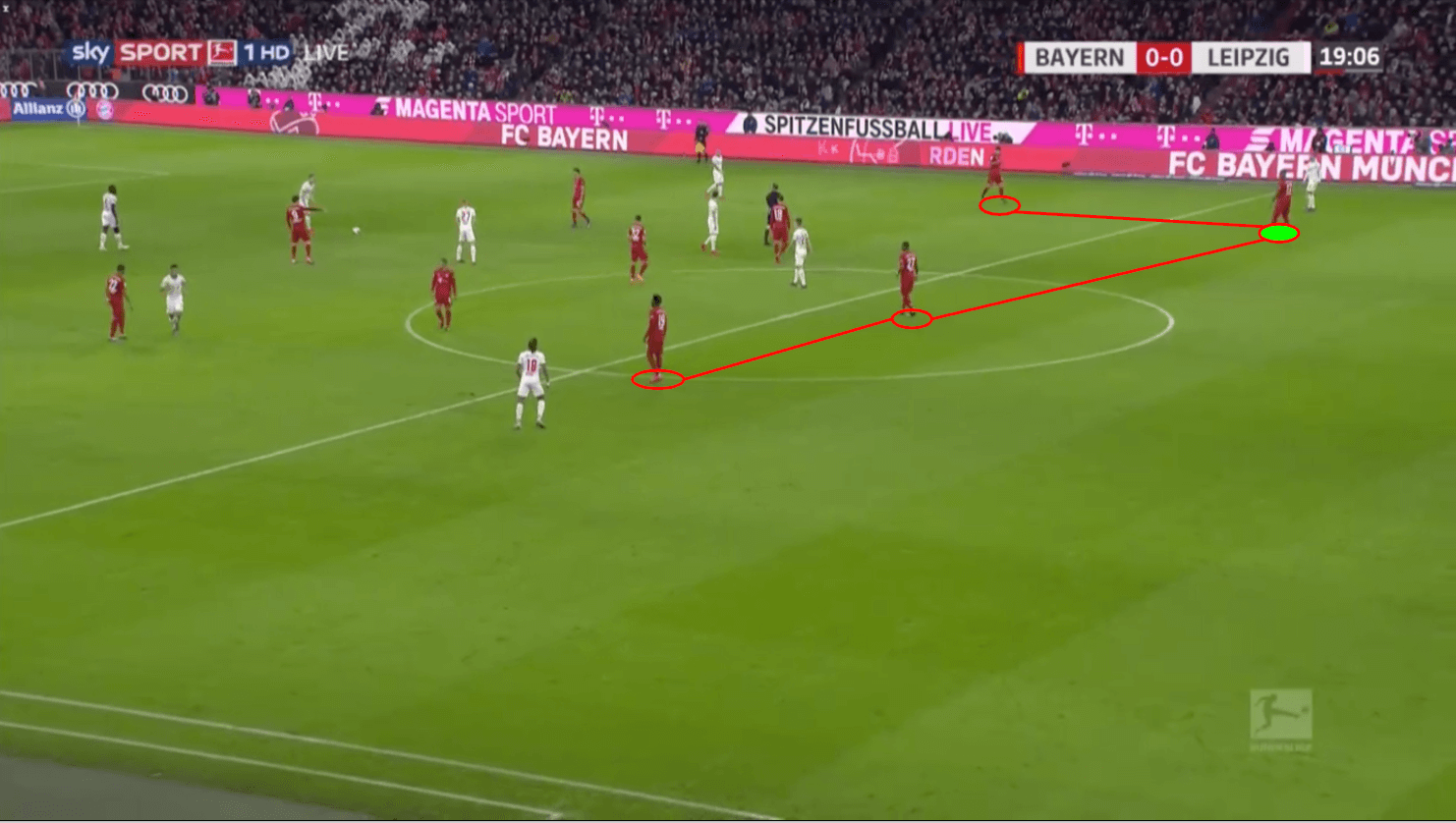
This image highlights the “back four” when Pavard would go forward. In the image, Boateng is marked in green, closely to Werner. While Boateng’s positioning did open up a large space between him and his centre-back partner, David Alaba, Boateng knew he needed to be closer to Werner. Simply put, Timo Werner would blow past Boateng in a race. So, Boateng intelligently used his positioning to neutralise Werner’s speed. If Werner attempted to run by him, he would take a step into his path. This accomplished two things: it slowed Werner down and gave Manuel Neuer more time to judge the path of any pass. With Neuer behind him, Boateng knew he’d have someone stepping up to intercept potential through-balls. This effectively neutralised Werner for most of the first half.
Boateng continued to defend Werner well by out-thinking the Leipzig forward and using his positioning to protect Bayern’s goal.
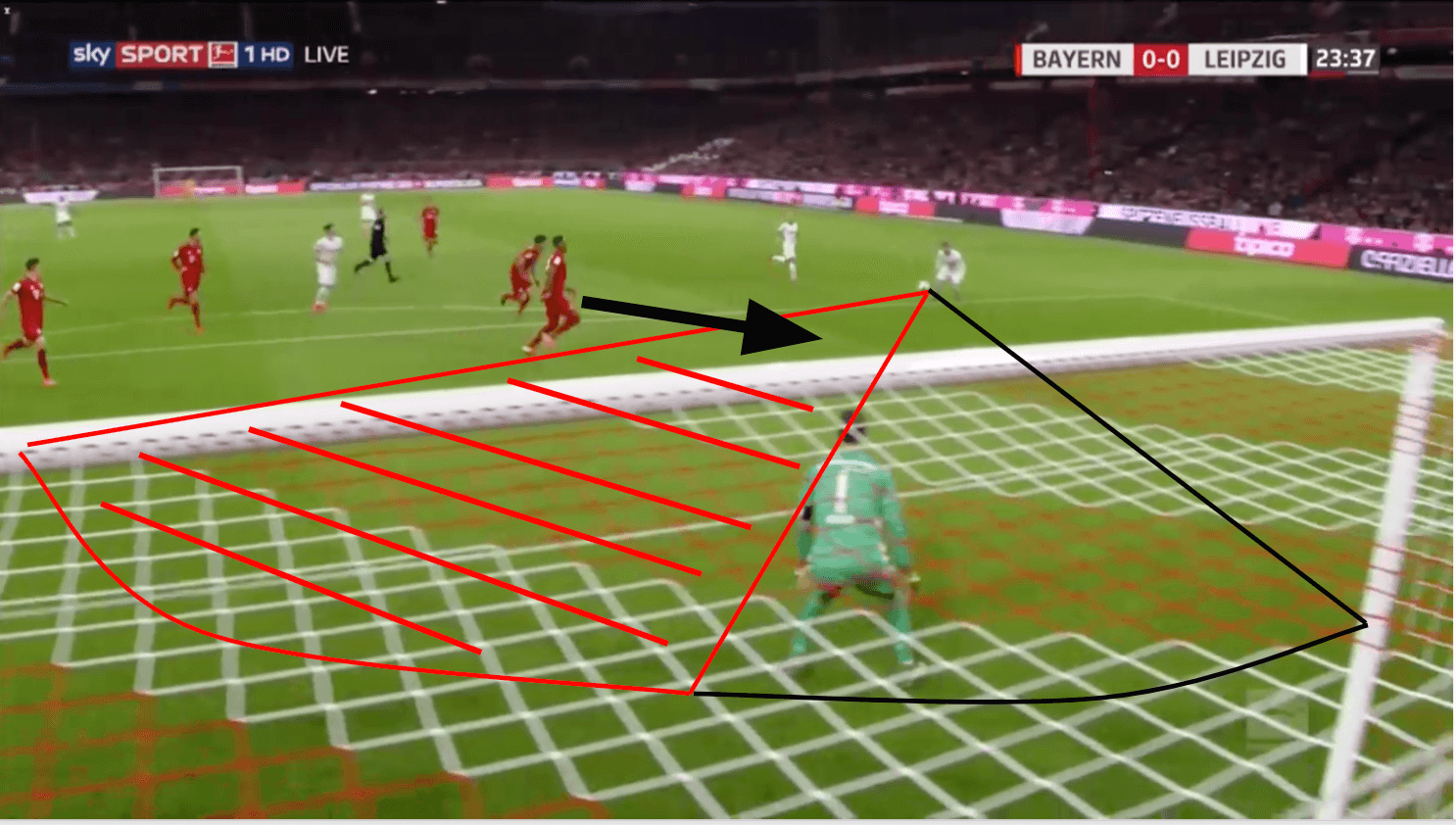
After Leipzig quickly switched the ball from an area overloaded with Bayern defenders to Werner on the left side, who found space for himself inside the penalty area. Boateng had to scramble to protect his goal, and his positioning was impeccable. Instead of rushing to meet Werner, Boateng slid over and reduced the angle of Werner’s shot. While Werner seemed to have the entire angle to shoot at, Boateng’s intelligent movement eliminated everything in red. If Werner would have attempted to shoot there, Boateng simply would have blocked his shot. This meant that Neuer now knew where Werner’s shot would be going, and he could worry about protecting his near post. By forcing Werner to go near post with his positioning, Boateng reduced his odds of scoring while making play predictable for his teammates. Timo Werner’s shot ended up missing the frame, and Bayern escaped unharmed.
Manipulation of opponent
While Boateng’s positioning is excellent, he also excels at recognising when Bayern are under pressure and need to escape it. His ability to constantly have his head up allows him to recognise where his opponents are and adjust accordingly to help create time and space. The first of these instances came against Leipzig, when Bayern had consecutive corners before Leipzig was able to clear the ball. As the ball came out, it bounced to Boateng, whose head was up, surveying his options.
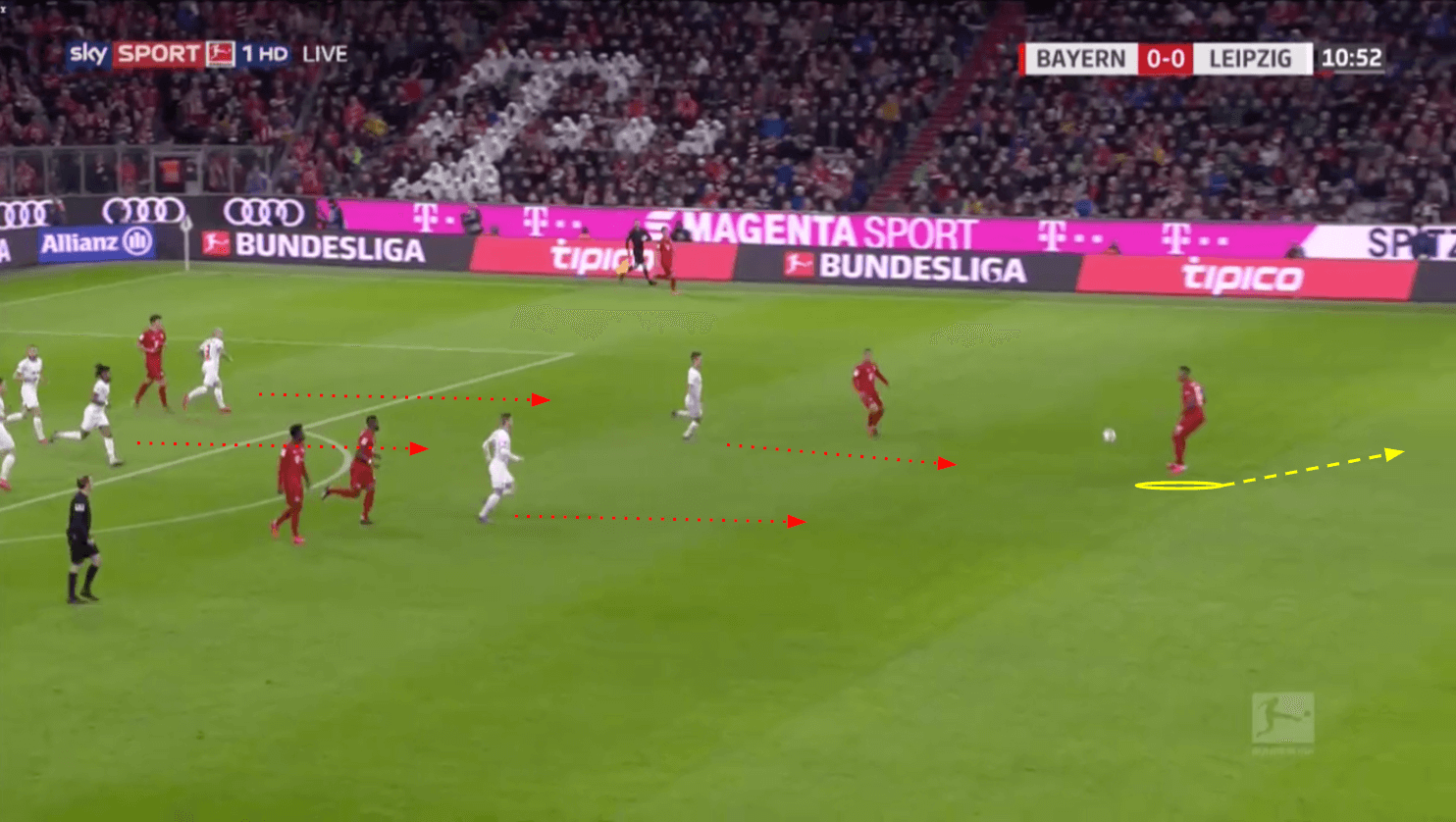
What Boateng saw was a wall of Leipzig players pushing up very quickly. If he were to play the ball back into the box, a majority of his teammates would have been ruled offside, effectively killing the play. Instead, Boateng let the ball bounce and retreated with it. As he did, the Leipzig players continued to press higher up the pitch, opening up more space for Bayern to attack. This allowed Bayern to make multiple attempts to play the ball over the top of Leipzig’s defence, with Boateng just narrowly missing Robert Lewandowski in the process.
Similarly, Boateng’s recognition of his opponents’ movements allow him to protect the ball and maintain Bayern’s possession. Later in the match against Leipzig, David Alaba, Bayern’s main ball-playing centre-back, was looking to connect with teammates up the pitch. Leipzig chose not to pressure Alaba, almost daring him to try and force a pass. Instead of doing that, Alaba laid the ball off to Boateng, playing the pass behind him, rather than to his feet.
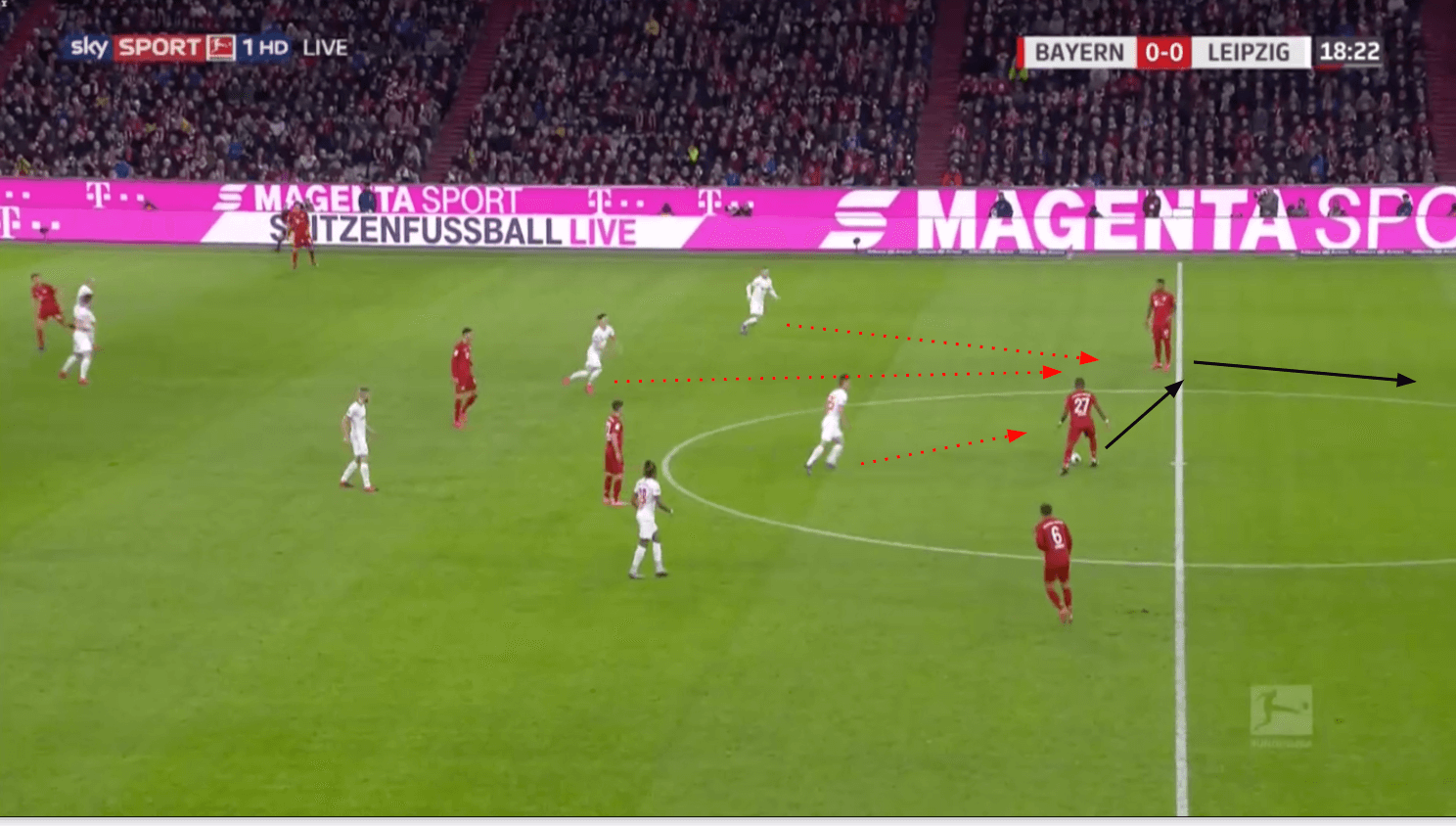
As soon as Alaba released the pass, three of the Leipzig defenders began to press, revealing one of their pressing triggers to Bayern. Boateng recognised the immediate pressure and didn’t hesitate. His first touch played the ball back to Neuer. As the ball moved back, Boateng and Alaba both dropped down lower and wider to provide angles of support to Neuer, and Bayern ultimately played their way up the pitch through their midfielders. This progression was allowed to continue because Boateng recognised pressure, mitigated the threat, and helped Bayern maintain possession.
His role in possession
When Bayern are in possession, Boateng does well to support his teammates and make sure he creates angles of support, which allows Bayern to enjoy the possession of the ball. One of the ways that he does this is through his positioning in relation to his teammates on the ball and his opponents.
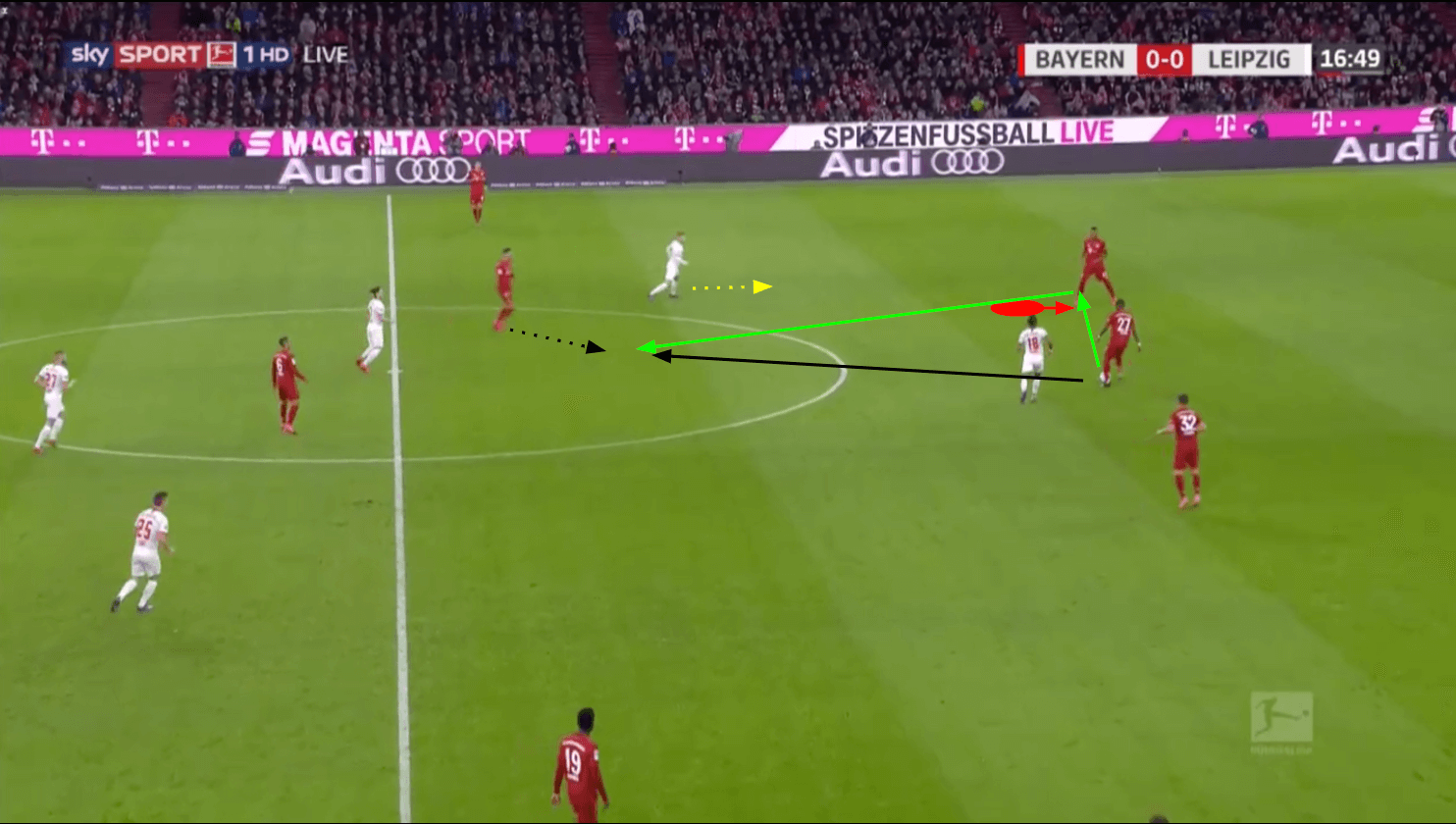
Here, Boateng does well to make sure he is one to two steps lower on the pitch than David Alaba, who is in possession of the ball. A lot of centre-backs will step into that red space, looking to progress forward with the ball. The problem with doing that is you are closer to defenders, which means it takes less time for them to close you down. This also creates more space for his teammates to exploit. In the image, Timo Werner stepped forward to put some pressure on Boateng, allowing more space to open up. Alaba now has two passing options: play it to Boateng (green arrow progression) who can progress the ball forward to Leon Goretzka or play it to Goretzka himself.
In the last image, Alaba opted to play Goretzka himself. When Boateng does receive the ball, he has the knowledge to combine with teammates in order to manipulate opponents. This is a small but classic example of using possession as a tool to manipulate your opponents.
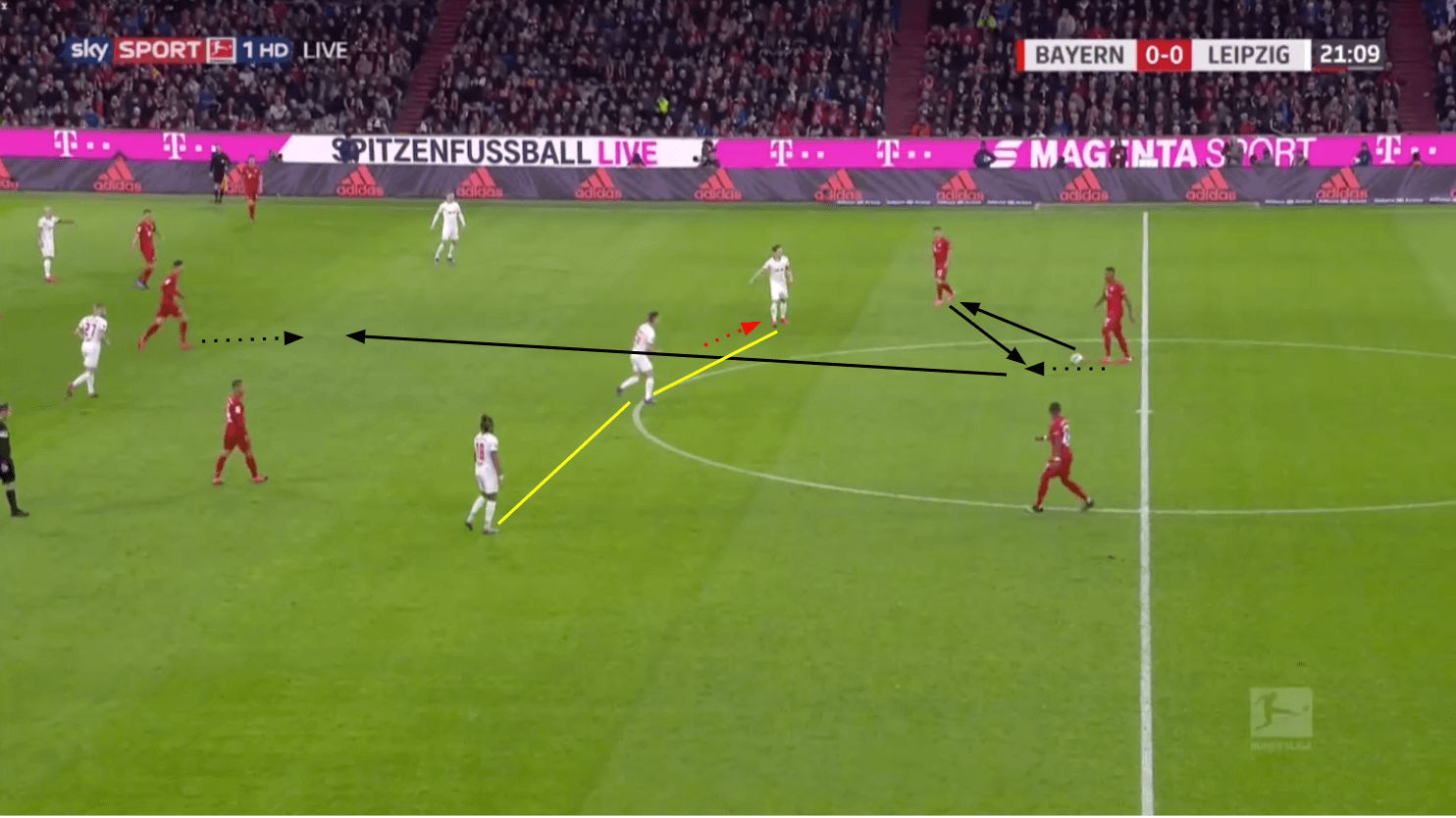
Joshua Kimmich slid out to the right of Boateng. Boateng played him a pass, which caused a reaction from Marcel Sabitzer, the Leipzig midfielder. As Sabitzer stepped to his left, a vertical passing lane opened up. Kimmich played the ball right back to Boateng, who took a touch and then broke the first defensive line of pressure with his pass to Goretzka. While Boateng certainly isn’t a more modern ball-playing centre-back, he can distribute consistently enough that he creates headaches for teams looking to shut down Bayern’s centre-backs. Even if you can slow down Alaba, who is the main distributor in the back, Boateng has the ability to step up and play passes through a defence.
Struggles with his lack of pace
While Jérôme Boateng certainly has a lot of strengths that make him a quality centre-back, his lack of pace seems to often find him as the last man back in Bayern’s line. In the image below, Boateng was man-marking Christopher Nkunku, and he needed to be close to him as previously discussed.
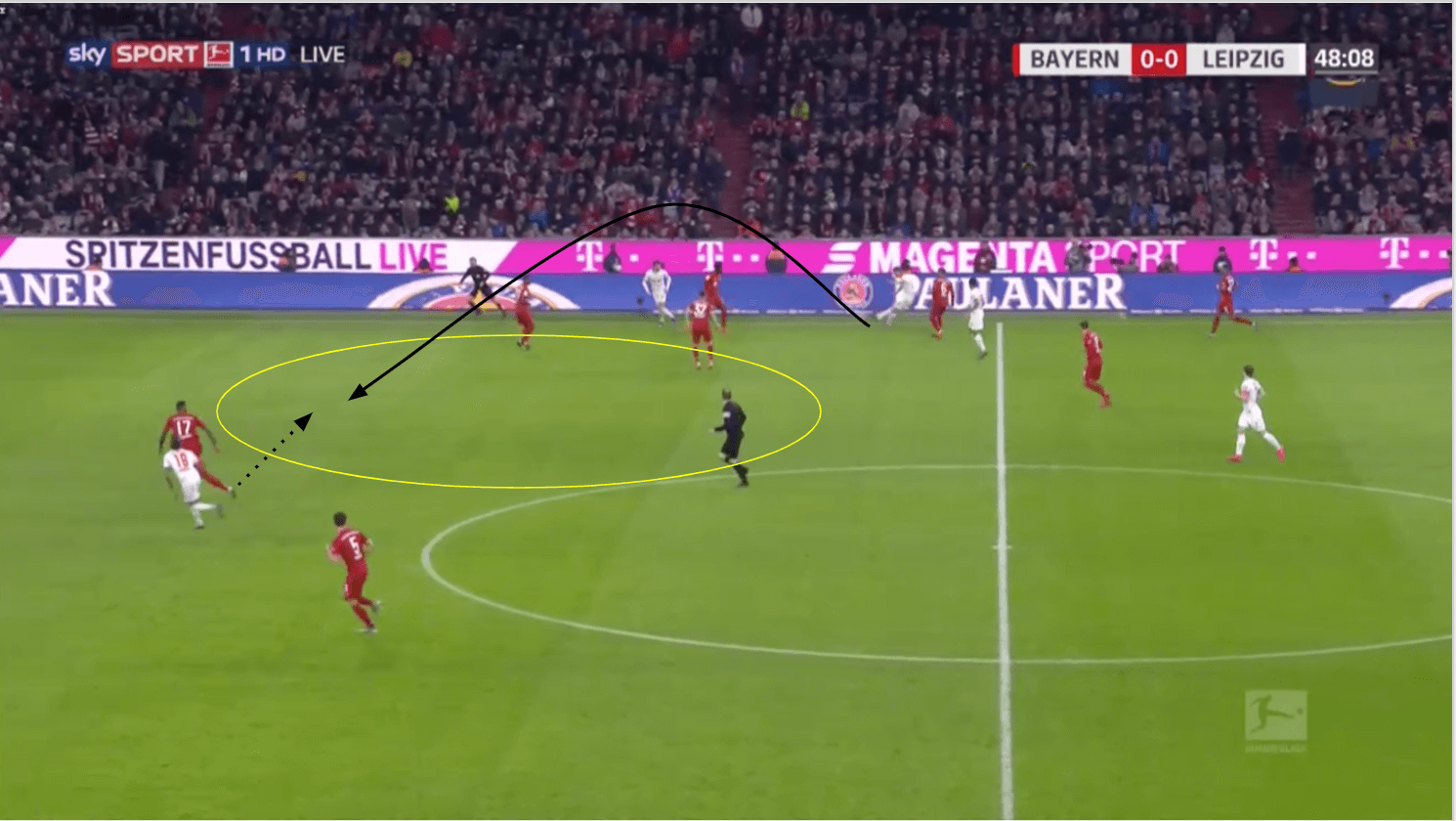
What this caused is a large channel of space to open up. When Leipzig played a bouncing ball into that space, Boateng had to make a split-second decision. If he let it bounce, Nkunku was surely in on goal. He went to challenge the ball; however, he was too far away to use his feet, so he went horizontal and tried to win it with his head, which he misplayed into the path of Timo Werner. Manuel Neuer sprinted out of his goal and slowed Werner down, but it realistically should have cost Bayern a goal.
Bayern were almost punished again by Leipzig because of Boateng. It’s clear that part of Julian Nagelsmann’s halftime adjustments looked to exploit Boateng’s lack of pace. In the 63rd minute, Nkunku did just that.
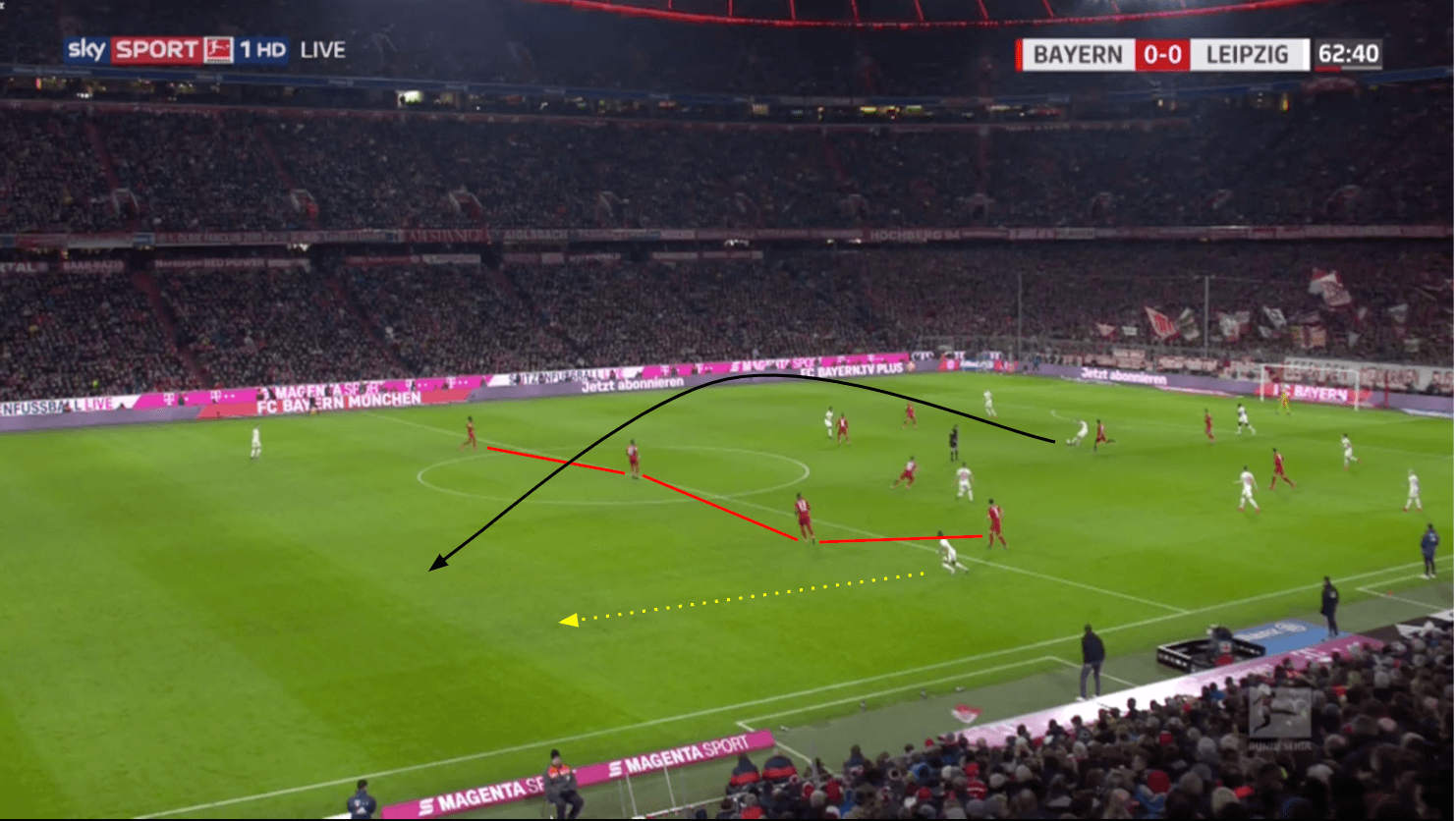
Again, Boateng was deeper than the rest of his defensive unit, trying to stay closer to the faster Nkunku. This kept Nkunku onside. If Boateng could have stepped up, he would have eliminated Nkunku as an option. Instead, the ball came in over the top of the defence, and Bayern were left absolutely caught out, with Nkunku and Werner essentially by themselves against Neuer. Nkunku set Werner up perfectly, but luckily for Bayern, Werner somehow managed to miss his wide-open opportunity.
Against FC Köln, Boateng’s lack of speed forced an error again. This time, the through ball came from the left-wing.
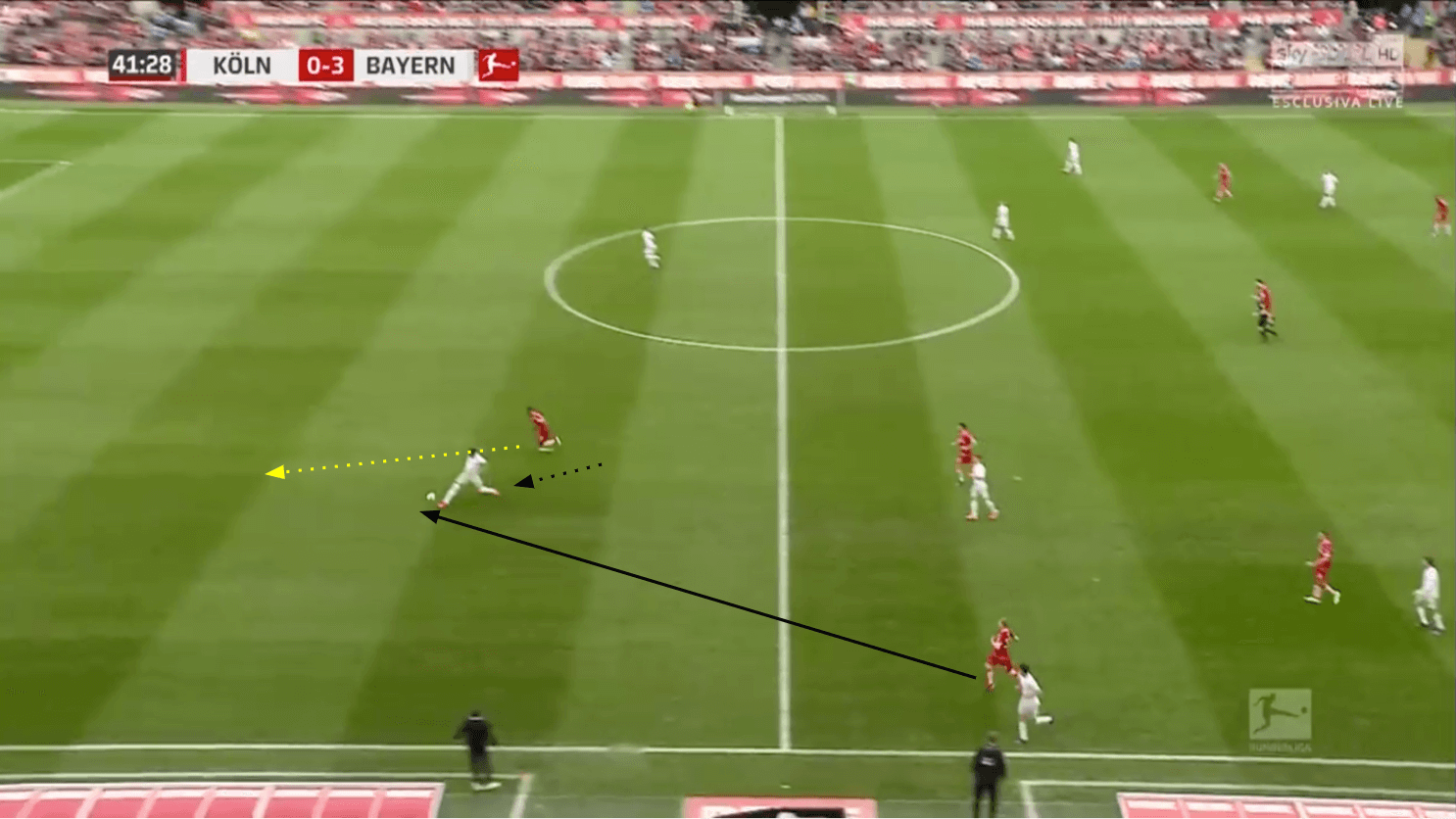
As the ball was played to the striker, Boateng took two steps and then had to lunge in an attempt to make contact. Similarly to the first through ball to Nkunku, if he hadn’t made any contact, the player would have been through. Again, Boateng made contact, but again, he didn’t make enough of it to eliminate the pass. And again, Manuel Neuer had to come to his rescue, coming incredibly far out of his goal to stop the threat. While Neuer does have this ability, Hansi Flick would almost certainly prefer that he didn’t need to use it so consistently. When Lucas Hernández and Niklas Süle return from injury, Neuer may not need to come out his goal as much, probably because Boateng won’t be on the pitch as much.
Conclusion
Boateng certainly still has a lot to offer at the age of 31. The 2016 German Player of the Year may make the occasional wrong decision, which admittedly hasn’t hurt Bayern yet, but it certainly could in the long-term. Assuming Hernández and Süle return to full health, Boateng may not find himself seeing as much playing time as the two younger centre-backs. While rumors of his time being up in Bavaria may come true, he would be a marked upgrade for many defensive units in Europe.





Comments